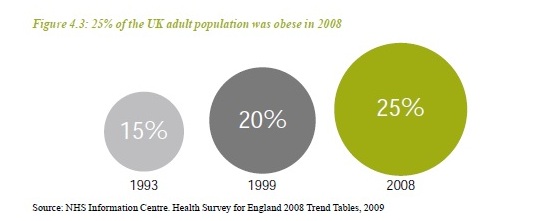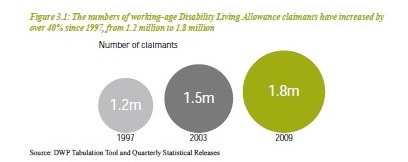Eeyore takes a look at Britain
Feeling cheerful? Then take a dip into a report that emerged recently from the Cabinet Office.
The State of the Nation Report on poverty, worklessness and welfare dependency in the UK is a catalogue of gloomy statistics seemingly designed to prove David Cameron’s claim that Britain is broken.
It ranges from the blindingly obvious – “Children living in couple households where no adult works have over a 64 per cent chance of living in poverty, compared with just a 1 per cent chance for those living in a household with two adults in full-time work” – to the downright questionable. For instance, is it true to claim that long-term dependency is increasing when the number of people receiving job-seekers’ allowance for over two years has fallen from 141,000 in 1999 to 25,000 in 2009?
Specialists in misleading graphics can have a lot of fun, too. The report makes the common but unforgivable error of displaying data as circles in which the diameter, not the area, is proportional to the number represented. For example, the growing problem of obesity is displayed by the graphic below:

We may be getting fatter, but not that fast. If the 1992 circle represents 15 per cent, then the 2008 circle certainly does not represent 25 per cent, as claimed. Its diameter is 1.7 times as great, so its area is 1.7 x 1.7 times as great – that is 2.9 times. As drawn, it’s closer to 45 per cent. There are lots of other graphics in the report that make the same error and, oddly, some that don’t. But you would have thought anybody could see this one is wrong:

There’s something else a bit peculiar about the data in this graphic, apart from the way it’s drawn. Although the report claims to be about the UK, these figures (according to my reading of the NOMIS labour market statistics), refer just to England and Wales. The total for the UK is considerably higher. So are the data in this report for the UK, for England, or for England and Wales? A footnote at the front tells us they can be any of these and promises to identify which, in each case. But it doesn’t.
Some of the conclusions smack of Eeyore, the gloomy donkey in Winnie the Pooh who could never see the bright side of anything. Personal debt, we are told, reached record levels over the past decade. But so did personal assets: never heard of the house-price boom?
Or try this. “Half of all people over 75 and over live alone, with nearly half of all older people (45 per cent) considering the television as their main form of company”. That, alas, is what happens when your partner dies, or if you don’t have one. ‘Twas ever thus. At least they’ve got TVs to keep them amused.
Other statements simply don’t justify the conclusions we’re asked to draw from them. “Of sons born to parents in the bottom 25 per cent of income distribution, 37 per cent are in the bottom 25 per cent by age 33-35” – so 63 per cent aren’t. That doesn’t strike me as too bad at all as an index of social mobility.
The same applies to claims about the intergenerational cycle of disadvantage. The report notes that “just over a quarter (27 per cent) of children from families experiencing six or more parent-related disadvantages also have three of more disadvantages themselves.”
Let’s analyse that for a second. First, the children have fewer disadvantages than their parents (three or more, rather than six) and it applies to only 27 per cent of them. The other 73 per cent presumably have escaped from disadvantage altogether, or at least suffer fewer than three.
By the next generation, the numbers will be 27 per cent of 27 per cent, or 7.3 per cent and by the fourth generation the dilution of the cohort will leave a pattern indistinguishable from the rest of the population, which is pretty well what we have always known. Most of us need go back no more than a generation or two to identify an ancestor with a handful of disadvantages. It’s not simple to escape, but families always have.
The report has an introduction by Iain Duncan-Smith, the Work and Pensions Secretary, who might perhaps be described as the Cabinet’s Eeyore. But he can’t have commissioned it, as he’s only been in office a few weeks. It’s hardly the message the last Government sought to propagate. No press release appears to have been issued. A bit of a mystery, in short.
We’ll be hearing a lot more of this kind of stuff, and of course it is right for Governments to try to improve people’s chances in life. It's just a pity they are not better at it. But there’s no need to exaggerate, and no excuse at all for duff graphics that lead the casual reader to false conclusions.
"It's snowing still," said Eeyore gloomily.
"So it is."
"And freezing."
"Is it?"
"Yes," said Eeyore. "However," he said, brightening up a little, "we haven't had an earthquake lately."
(The House at Pooh Corner)



